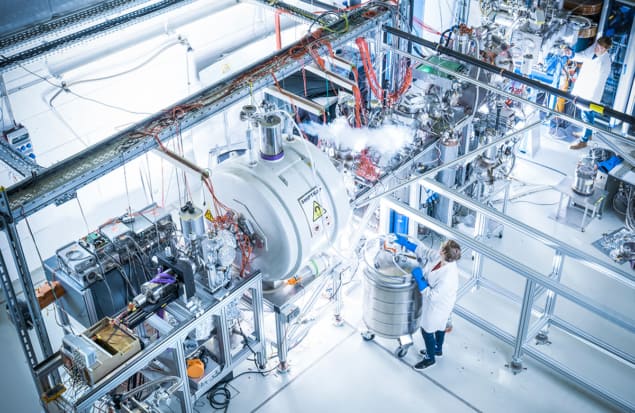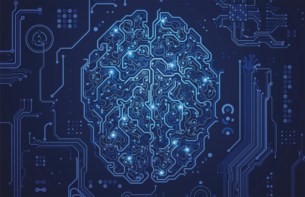Hamish Johnston reviews Superheavy: Making and Breaking the Periodic Table by Kit Chapman

Atomic nuclei have been intensely researched for more than a century, but they remain things of mystery and wonder – especially to the nuclear physicists who study them. We know that nuclei are made of protons and neutrons bound together by the residual strong force. But the extreme difficulty of calculating nuclear properties using the Standard Model of particle physics leaves much to be learned about their internal workings. In a sense, nuclei are like the world’s oceans: despite their ubiquity, we are still on the shoreline trying to understand what lies in their depths.
Nuclei are made of just two components, but their properties can be very different indeed. Most of the nuclei in your body, for example, have been around for billions of years, yet some rare nuclei made in the lab can last just tiny fractions of a second before decaying. It is the heaviest of these rare nuclei, and the people who devoted their careers to discovering and characterizing them before they decay, that are the subject of Superheavy: Making and Breaking the Periodic Table by the pharmacist turned science writer Kit Chapman.
The book takes the reader on a romp that begins in 1930s Paris, when Irène and Frédéric Joliot-Curie discovered that heavier elements could be made by bombarding lighter elements with alpha particles (helium nuclei). This was followed shortly thereafter in Rome by Enrico Fermi and the “Via Panisperna Boys” who found that bombardment with neutrons had a similar effect.
The race was on to find new heavy elements and the result was a transformation of the periodic table – which is conveniently included in the frontmatter of Chapman’s book. Like many physicists, the last time that I had a serious look at a periodic table was when I took my last chemistry course – which was 35 years ago – and I rather sheepishly admit that studying the table once more was a revelation. Indeed, I wondered aloud “Where did all those new superheavy elements come from?” Even though as a physics journalist I have covered the twists and turns in the discovery and naming of new elements over the past two decades, I had always looked at each element in isolation and did not fully appreciate how the periodic table – full of holes when I was young – appears much more complete, at least for now.
What I mean by complete is that in the current incarnation of the familiar version of the table, the seventh and final row is full of elements named after people and places – there are no gaps and no systematic names such as unnilseptium that were placeholders as scientists argued over element names. The seventh row begins on the left with francium and radium; is punctuated by the 14 actinoids (from actinium to lawrencium); and then makes the sprint across the transition metals and on towards the noble gases.
The superheavy elements are the final 15 in this row, from rutherfordium with 104 protons, on to dubnium and eventually to oganesson with 118. Those last two names, by the way, reflect the importance of the Soviet/Russian Joint Institute for Nuclear Research (JINR) in the search for superheavy elements. The lab is in Dubna, near Moscow and since 1989 it has been run by Yuri Oganessian. Strictly speaking, new elements should not be named after living people, but two exceptions have been made – oganesson (118) and seaborgium (106), the latter honouring the nuclear chemist Glenn Seaborg, who created and ran the rare elements programme at the University of California, Berkeley.
GSI in Darmstadt, Germany, and RIKEN’s Radioactive Isotope Physics Laboratory in Japan were also major contributors to the discovery of the superheavy elements. They have been honoured with the names darmstadtium (110), hassium (108) and nihonium (113) – the last two inspired by the Latin name for the German state of Hesse and an alternative name for Japan.
Like many things in modern physics, the drive to create superheavy elements began in earnest during the Second World War with the race to build the atomic bomb – and specifically the development of a way to produce significant amounts of plutonium. That element was discovered in 1941 at the University of California Berkeley by a team that included three future Nobel laureates: Seaborg, Emilio Segrè and Edwin McMillan.
Chapman reveals that Seaborg chose the symbol Pu for plutonium because of the stench of his Berkeley chemistry lab. Although physicists had played an important role in the early discovery of new elements – the work of Seaborg and colleagues was made possible by the cyclotron, which was invented at Berkeley by the physicist and Nobel laureate Ernest Lawrence – it was chemists who isolated the new elements from bombarded targets. This was no mean feat; not only did they have to predict the chemistry of an element that had never been seen before, they also had to work very quickly because the elements have short half-lives. Indeed, Chapman tells us that Berkeley nuclear scientist Albert Ghiorso famously used a souped-up Volkswagen Beetle to transport samples in the shortest time possible across the campus, from where they were made to where they were analysed.
Because much of the early effort to create new elements occurred during the Second World War and the Cold War, there was a certain amount of censorship involved in publication of the work. Before the US entered the war in 1941, Chapman points out that the British were concerned that American scientists were providing the Germans with information that could be used to create nuclear weapons. In 1945 US officials prevented the publication of a Superman comic strip because the superhero was irradiated in a cyclotron – which was described with too much accurate detail for wartime censors.
While Seaborg is the scientist most associated with the discovery of new elements, it is Ghiorso who holds the record for being involved in the most discoveries. In 1993 he helped discover element 106, putting his tally at 11 and beating the 185-year record held by Humphrey Davy. Because the discovery was made at Berkeley, the lab gained the right to name the element. This was at a time when Berkeley, JINR and Darmstadt were in competition to find and name new elements.
The days of isolating new elements and studying their chemistry was waning. By the 1990s researchers often only caught fleeting glances of new elements and had to try to determine their decay chains – often only seeing part of the picture. Science is usually done incrementally with different labs contributing evidence that eventually adds up to a discovery – giving priority as to who made a discovery and who therefore had naming rights was a tricky business.
While this competition between labs resulted in a flurry of new elements, the labs were at loggerheads when it came to naming the new elements. This ruckus was dubbed the “Transfermium Wars”, with transfermium referring to elements beyond fermium (100). The wars ran for about 30 years, starting in the 1960s, and during this period three different elements had been named rutherfordium by different research groups and three different names had been proposed for element 102. What is more, two different names had been proposed to honour the Danish physicist Niels Bohr – bohrium and nielsbohrium – the latter favoured by the Germans who were concerned that bohrium could be confused with boron.
In 1986 the Transfermium Working Group was set up by the governing bodies of chemistry and physics (IUPAC and IUPAP respectively) to sort out the mess and after a decade-long slog it finally came up with a definitive list of names in 1997 – and bohrium (107) won out over nielsbohrium.
Atoms formed by superheavy elements have properties that are not predicted by their position in the periodic table
As for the future of the superheavy element hunters, Chapman writes that the best guess of physicists is that there could be as many as 172 elements – which means more than 50 could still be up for discovery. But Chapman also points out that discovering more and more heavy elements could be the undoing of the periodic table, bringing about the “end of chemistry”. While that might sound ominous, I’m afraid it doesn’t mean that chemistry students of the future can avoid learning how to balance redox reactions. What Chapman means is that the atoms formed by superheavy elements have properties that are not predicted by their position in the periodic table – a cornerstone of chemistry.
An early hint of this is that research using tiny numbers of copernicium (112) and flerovium (114) atoms at Dubna suggests that the element’s chemical properties are not as expected given its place in the periodic table. Flerovium, for example, should behave like lead, which is the element above it in the periodic table and copernicium should behave like mercury – but that is not what the study found. The likely reason is that these elements have huge charges on their nuclei and large numbers of electrons, so that conventional way of understanding how these elements react breaks down.
So rather than heralding the end of chemistry, the superheavy elements look set to open an exciting new chapter.
- 2021 Bloomsbury Sigma £10.99pb 304pp



